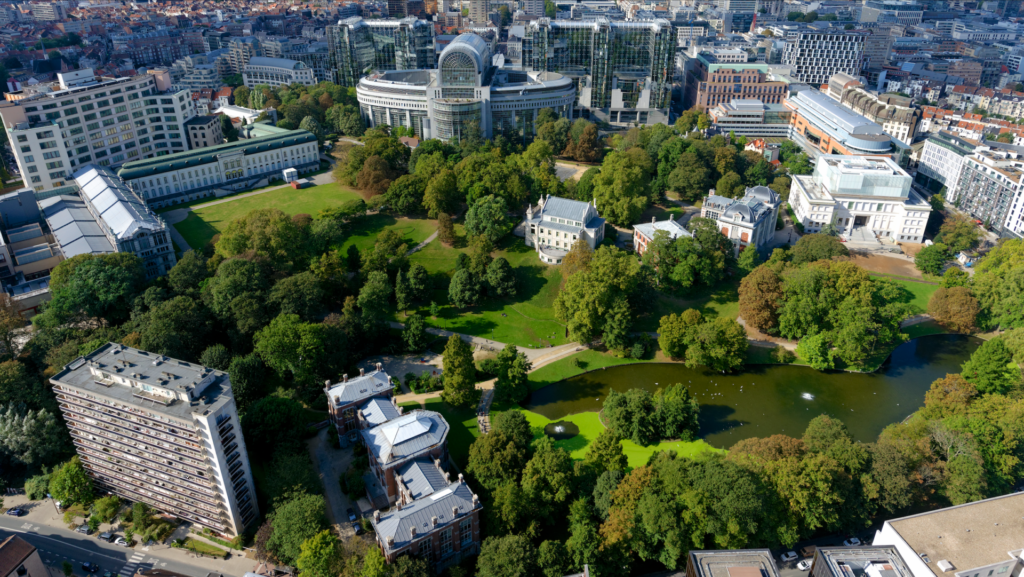Brussels is pushing ahead with its plans to transform the European Quarter from a dull and office-dominated area into a vibrant and mixed neighbourhood. On Thursday, the quarter's "new identity" for this purpose was finally unveiled.
From making the chaotic Schuman roundabout greener and more pedestrian and cyclist-friendly to revamping the iconic Parc de Cinquantenaire at the heart of the European Quarter, it is no secret that the Brussels Government is looking to change the perception of the neighbourhood and ensure that it becomes a space for living, not just for working. However, the latter has proved to be the most challenging aspect of the mission.
"People are working and living here. But you also have many Brussels residents who don’t want to even pass through here because they think there is nothing here for them," Brussels Commissioner for Europe and International Organisations Alain Hutchinson told The Brussels Times.

The future is Europe. Credit: visit.brussels/Jean-Paul Remy
"Among locals, the neighbourhood is criticised for being office-heavy, filled with civil servants, and being closed during evenings and at the weekend because of office hours. Our job now is to try and change this and make the quarter a real part of Brussels where all residents want to spend time."
For this purpose, the Brussels-Capital Region and the three municipalities involved have worked alongside EU institutions to set up a new and shared strategy for the neighbourhood. It has been presented under a new brand "European Quarter Brussels", which has been a process for four years in the making and was unveiled on Thursday. Eventually, it is hoped the EU Quarter can become a real Brussels tourist attraction, comparable to the Grand Place and Bourse.
Bottom-top initiative
The European neighbourhood, located on the territory of the municipalities of Brussels, Etterbeek and Ixelles, is a key area in the region for political and economic reasons. It is the main centre of international employment in the Brussels-Capital Region and almost all European institutions are housed here.
However, this has contributed to it acquiring an institution-dominated image, which was further exacerbated by the lack of shops, housing and quality public spaces.
In recent years, cafes and restaurants started popping up here and there, but now the various parties involved have started a process to mindfully develop a mixed neighbourhood with a wider range of housing, high-quality public spaces and cultural activities for all, as is being done in the Northern Quarter.

Square de Meeûs. Credit: visit.brussels/ Eric Danhier
The new brand aims to highlight the area's assets such as Cinquantenaire Park, Leopold Park, lively commercial centres (Jourdan, Merode, Luxembourg, Jean Monnet) and the district's world-renowned museums.
"It is a real bottom-top initiative that concerns all people here and everyone was involved in building this brand. In this process, we noticed a keen interest among residents and shopkeepers to get this initiative launched and bring life to the European quarter," Hutchinson said.
"This brand is not just a logo, but the start of a love story, and it is hopefully going to give a colourful image to this quarter that is widely considered to be grey and dull."
The housing issue
More recently, the neighbourhood has become more popular with tourists, mainly due to the renowned museums located here, but it remains unpopular among people who have lived in Brussels for a longer time, especially when it comes to living here.
"This is a shame, as this quarter is so much more than just office buildings. People meet here, it has an original character, and it is international and multicultural. Brussels residents should also consider living here because this is also part of their city," Ans Persoons, Brussels State Secretary for European and International Relations said.

Parc Léopold. Credit: visit.brussels/ Jean-Paul Remy
"However, I believe this is the beginning of a big process and people will realise that there are plenty of reasons to come here. I dream of a European Quarter that can reflect the variety of Europe apart from that institutional aspect."
While the brand aims to change the perception among locals in this way, efforts are being made to transform the many office buildings into multi-functional buildings. Persoons said that there is real momentum for this, as the European Commission is selling many of its old offices – amounting to 350.000 m2 of office buildings – and opening up the door for reducing the heavy presence of the EU in the area itself.
"I think the efforts to create housing will succeed because this offers a real opportunity to create housing," she told The Brussels Times. "There is also a shared vision of the city and region as to what to do with those buildings, and we agree that a lot of offices should be converted into housing."
Related News
- The roundabout at the heart of Europe: Works to redevelop Schuman to start
- How Brussels is bringing its people into decision-making
However, as is the case in many other neighbourhoods across the region, the question of how to make housing affordable here is looming over the heads of the Brussels Government as the cost of land in the neighbourhood is very high.
"For me, keeping housing in the neighbourhood will be one of the key points in this initiative, and that's also one of our objectives, but that's not at all easy to achieve. Making that happen lies with the Brussels government, they have to ensure money is also freed up to do so," she concluded.

